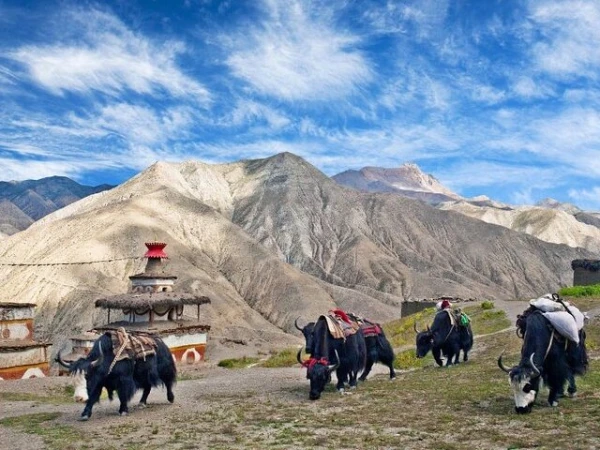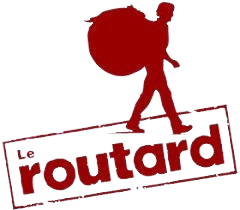Overview of Dolpo Trek
Embark on an extraordinary adventure to Nepal's remote Upper Dolpo region, a hidden gem nestled in the far western Himalayas. This trek offers a rare blend of untouched natural beauty, rich Tibetan-influenced culture, and unparalleled solitude. Recognized as one of Nepal's most challenging and rewarding treks, the Upper Dolpo Trek is ideal for seasoned trekkers seeking an authentic wilderness experience.
Trek Highlights
Phoksundo Lake: Marvel at the turquoise waters of Phoksundo Lake, one of Nepal's most pristine and sacred alpine lakes.
Shey Gompa: Visit this ancient Bon-Po monastery, a spiritual center dating back over 800 years, offering insights into pre-Buddhist traditions.
Kang La & Saldang La Passes: Cross two high-altitude passes, Kang La (5,360m) and Saldang La (5,200m), each offering panoramic views of the Himalayan ranges.
Shey Phoksundo National Park: Trek through Nepal's largest national park, home to diverse wildlife including snow leopards, blue sheep, and Himalayan black bears.
Traditional Villages: Experience the ancient Tibetan-influenced cultures of villages like Ringmo, Saldang, and Dho Tarap, where time seems to stand still.
Main Trekking Route
Kathmandu to Nepalgunj: Fly from Kathmandu to Nepalgunj, the gateway to western Nepal.
Nepalgunj to Juphal: Take a scenic flight to Juphal, the starting point of the trek.
Dunai to Ankhe: Trek through terraced fields and small villages.
Sulighat to Phoksundo Lake: Ascend to the stunning lake, spending a day acclimatizing.
Phoksundo Bhanjyang to Shey Gompa: Cross Kang La Pass and reach the sacred monastery.
Namduna Gaun to Saldang: Traverse high-altitude terrain with views of Dhaulagiri.
Yangze Gompa to Tokyu Gaon: Visit the Bon-Po monastery and continue to Tokyu Gaon.
Dho Tarap to Tarap Khola: Descend into the Tarap Valley, known for its rich culture.
Tarakot to Dunai: Follow the river back to Dunai.
Juphal to Kathmandu: Conclude the trek with a flight back to Kathmandu.
Best Time to Trek
Spring (March to May): Enjoy pleasant temperatures and blooming rhododendron forests.
Autumn (September to November): Experience clear skies, stable weather, and stunning mountain views.
These seasons offer the most favorable conditions for trekking in the Upper Dolpo region.
Benefits of Booking with Us
Expert Guidance: Our experienced, government-licensed guides ensure safety and enrich your journey with local knowledge.
Comprehensive Permits: We handle all necessary permits, including the Upper Dolpo Restricted Area Permit and Shey Phoksundo National Park entry fees.
Comfort & Safety: Enjoy comfortable accommodations, nutritious meals, and necessary camping gear.
Support Staff: Our team includes porters, cooks, and medical personnel to assist throughout the trek.
Emergency Preparedness: Equipped with first aid kits, oximeters, and communication devices for any unforeseen situations.
Cultural Immersion: Engage with local communities, experiencing their traditions and way of life.
Eco-Friendly Practices: We prioritize sustainable trekking practices to minimize environmental impact.
Is This Trek Right for You?
The Upper Dolpo Trek is suitable for trekkers who:
Have previous high-altitude trekking experience.
Possess a good level of physical fitness and mental resilience.
Seek an off-the-beaten-path adventure away from crowded trails.
Are interested in exploring unique cultures and pristine natural environments.
Preparation Tips
Physical Training: Engage in cardiovascular and strength training exercises to build endurance.
Gear Up: Ensure you have appropriate clothing and equipment for high-altitude trekking.
Health Precautions: Consult with a healthcare provider regarding vaccinations and altitude sickness prevention.
Insurance: Obtain comprehensive travel insurance covering trekking and emergency evacuation.
Mental Readiness: Prepare for challenging conditions and remote environments.
What to Expect
Solitude: Experience one of Nepal's least-visited trekking regions.
Cultural Immersion: Engage with local communities and learn about their traditions.
Natural Beauty: Witness diverse landscapes, from lush forests to arid highlands.
Wildlife Encounters: Spot rare species in their natural habitat.
Key Challenges of the Upper Dolpo Trek
1. High Altitude & Risk of Altitude Sickness
Elevation: The trek reaches altitudes exceeding 5,000 meters, with several days spent above 4,000 meters.
Altitude Sickness: Symptoms can include headaches, nausea, dizziness, and shortness of breath. Proper acclimatization, hydration, and recognizing early symptoms are crucial.
2. Strenuous Terrain
Trail Conditions: Expect steep ascents and descents, narrow cliffside paths, rocky trails, and river crossings.
Trail Length: The trek spans approximately 220 kilometers, with daily hikes averaging 6–8 hours over rugged terrain.
3. Extended Trek Duration
Duration: The trek typically lasts between 20 to 27 days, including acclimatization and rest days.
Physical Demand: Continuous trekking over several weeks can be physically taxing, requiring endurance and stamina.
4. Unpredictable Weather
Temperature Variations: Expect temperatures ranging from -10°C at high passes to 14°C at lower altitudes.
Weather Conditions: Be prepared for snow, rain, hail, and strong winds, especially at higher elevations.
5. Limited Infrastructure
Accommodation: Lodging options are scarce; most nights are spent camping.
Facilities: Basic amenities like medical facilities and communication services are limited or nonexistent.
6. Remote Location
Accessibility: The region is secluded, with minimal interaction with the outside world.
Self-Sufficiency: Trekkers must be prepared to manage in isolation, carrying necessary supplies and equipment.
Emergency Preparedness: Safety Measures
Given the trek's remoteness, it's vital to be prepared for emergencies:
Medical Support: The Nomads Clinic has historically provided medical assistance in Dolpo, offering services like vaccinations and medical supplies.
Evacuation Protocols: In case of severe altitude sickness or injury, evacuation is challenging and may require helicopter rescue, which can be costly.
Travel Insurance: Ensure your insurance covers high-altitude trekking and emergency evacuation.
Guided Treks: Hiring a licensed guide is mandatory and provides local expertise and support in emergencies.






.webp)





